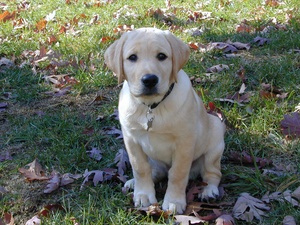In this fourth and final blog in a series about preventable inherited diseases in the Labrador retriever (see previous blogs here; part one, part two, and part three), we will examine a potentially life-threating urinary disease and a cause of blindness in dozens of dog breeds including the Labrador.
Cystinuria
Urinary tract obstruction is one of the most urgent and potentially life-threatening conditions in dogs. One common cause of urinary obstructions in dogs is the presence of bladder stones which leave the bladder during urination and become lodged in the urethra. The inability to urinate results in a toxic buildup of certain electrolytes and waste products in the body including potassium, which tends to be the most concerning in regards to health effects. Excess potassium in the body prevents the heart from beating normally, ultimately resulting in death due to cardiac arrest. Though it is not the only cause of bladder stones in Labradors, a genetic mutation in the SLC3A1 gene is reported to cause an early-onset disease known as cystinuria, which can result in bladder stone formation.
While normal kidneys reabsorb a variety of nutrients and electrolytes from the urine, dogs affected with cystinuria lack the ability to produce ...






